To keep soap making cool, maintain temperatures between 90-110°F (32-43°C) using digital or infrared thermometers. Pre-cool your lye solution in ice baths and refrigerate liquid oils before mixing. Work during early morning hours when ambient temperatures are lower, and set up fans or air conditioning in your workspace. Select liquid oils over hard butters in summer formulations, as they're easier to manage. These temperature controls will help prevent false trace and guarantee your soap cures properly.
What Temperature Controls Keep Soap Making Cool?
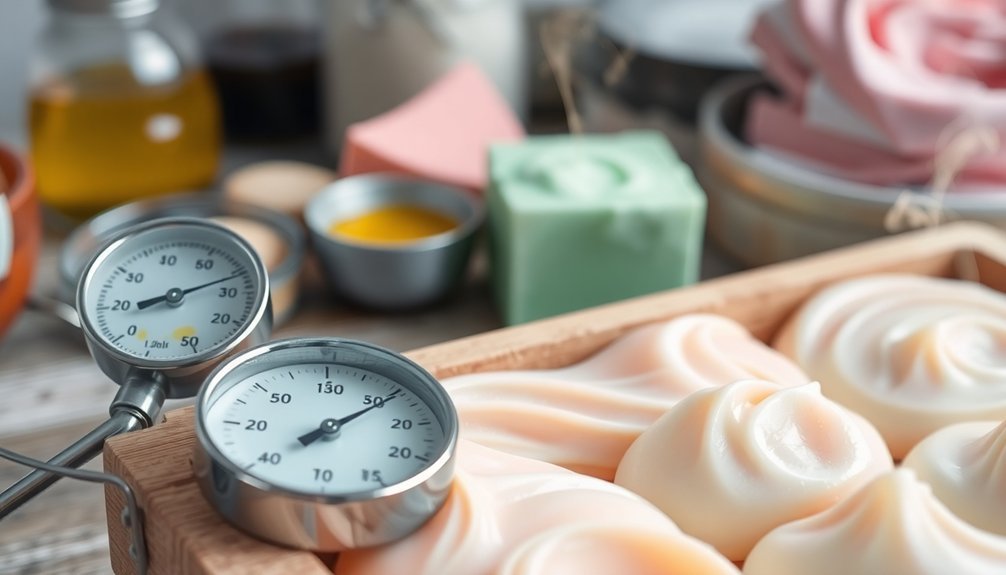
While creating handmade soap can be a rewarding craft, maintaining proper temperature control is essential for successful results.
You'll want to keep your soap-making process between 90°F and 110°F (32°C-43°C) for ideal workability and to prevent rapid trace.
Digital laser thermometers or infrared temperature guns provide the most accurate readings without direct contact with your materials.
For specialized techniques like working with milk or juice, you'll need even cooler temperatures to prevent scorching.
The heat transfer method offers an effective approach for cool soap making – using lye's heat to melt oils and butters rather than external heat sources. This method can reach temperatures of around 200°F (93°C) when lye is mixed with water.
This works best with recipes high in soft oils.
The Science Behind Ideal Soap-Making Temperatures
The chemical reactions in soap making follow precise thermal patterns, with saponification accelerating at higher temperatures and slowing as things cool.
You'll notice distinct phase changes during the process, from initial trace through gel phase when your soap exceeds 160°F, creating visual cues that indicate molecular restructuring.
Tracking these temperature-dependent transformations with accurate thermometers helps you control both the speed of your reactions and the quality of your final product. Understanding these patterns allows soapmakers to adjust their lye concentration for better temperature management throughout the saponification process.
Thermal Chemistry Basics
Understanding thermal chemistry fundamentals can transform your soap-making results from unpredictable to consistently excellent.
At its core, saponification is an exothermic reaction, releasing heat when NaOH dissolves in water and reacts with oils. Each triglyceride molecule requires three sodium hydroxide molecules to complete the saponification process. This reaction accelerates at higher temperatures, potentially causing problems like lye hot spots or incomplete emulsification.
You'll achieve the best results by maintaining temperatures between 90°F and 110°F (32°C to 43°C) for cold process soaps. Never exceed 120°F (49°C) as this dramatically speeds up saponification, giving you less control.
Temperature also influences your soap's final properties—cooler temperatures slow curing time, while higher temperatures can enhance color vibrancy through gel phase.
Different recipes may require temperature adjustments, especially those containing heat-sensitive ingredients like milk or certain fragrances.
Monitoring Phase Changes
Why do professional soap makers monitor temperature so meticulously? The answer lies in phase changes—particularly the gel phase, which occurs when soap reaches approximately 160°F (71°C). This critical transformation influences your soap's final appearance and quality.
- Gel phase enhances color vibrancy and creates a distinctive shine in finished soaps.
- Different ingredients have unique melting points—beeswax requires 149°F (65°C) while milk soaps need cooler temperatures.
- Digital thermometers prevent temperature guesswork that can lead to false trace or scorched additives.
- Temperature directly impacts saponification speed—hotter mixtures react faster, limiting design time.
- Maintaining oils between 90-110°F (32-43°C) when mixing with lye guarantees proper emulsification.
Incorrect temperatures often lead to serious issues like soap cracking or separation, especially when makers rush the cooling process before combining ingredients.
Monitoring these phase changes isn't just about following recipes—it's about controlling the chemistry that transforms raw ingredients into beautiful, stable soap.
Mastering the Heat Transfer Method in Warm Weather
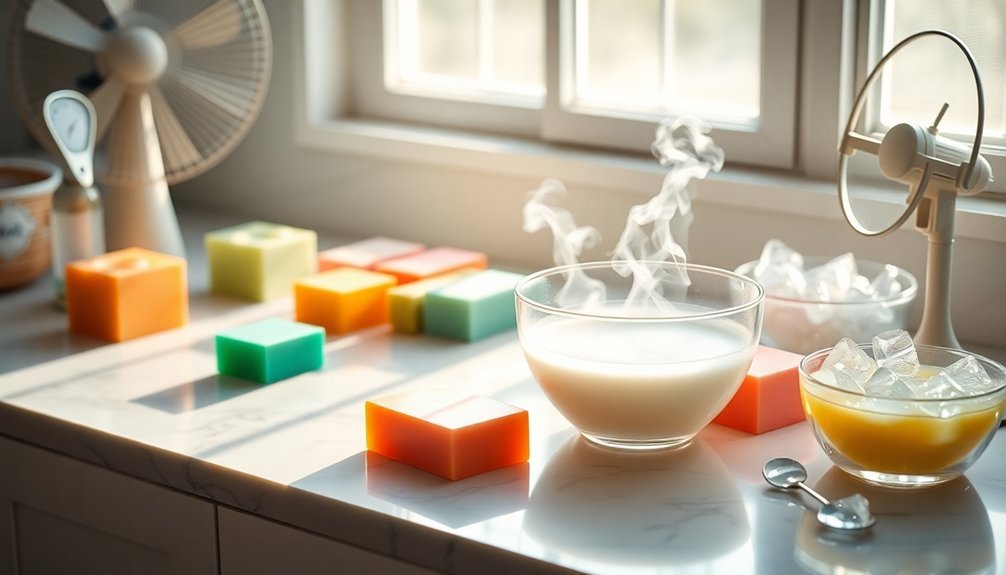
When making soap using the heat transfer method in warm weather, you'll need to carefully manage your lye solution temperature to prevent overheating while still effectively melting hard oils.
You can minimize external heat influences by working in a cooler room or reducing your typical soaping temperatures to around 100°F-110°F.
For ideal oil melting, consider the melting points of your ingredients and potentially combine hard oils with higher percentages of liquid oils to improve the effectiveness of heat transfer. Remember that all hard oils and butters must be thoroughly melted to ensure a smooth mixture and prevent false trace during the soaping process.
Lye Heat Management
Although the exothermic reaction of lye with water can reach temperatures up to 200°F, you can harness this heat strategically in your soap making process.
During warm weather, controlling this initial heat becomes even more critical to prevent accelerated saponification.
- Prepare your lye solution 1-3 hours before mixing to allow cooling to 120-130°F
- Use the natural heat to melt hard oils and butters without external heating sources
- Never reheat lye directly—opt for gentle warming in a hot water bath if needed
- Monitor temperature with a reliable thermometer to maintain ideal control
- Keep your workspace ventilated to manage both lye fumes and ambient temperature
This strategic temperature management is particularly important for recipes containing high saturated fats which require more careful temperature control to avoid issues like false trace or separation.
Minimizing External Warmth
External heat sources can greatly disrupt your soap making process, especially during warmer seasons when ambient temperatures already challenge your control. Keep your soap away from radiators, direct sunlight, and warm surfaces during both preparation and curing phases. This control is particularly important when working with recipes that use high amounts of liquid oils, as their properties can be affected by excessive heat.
| Heat Source | Impact | Solution |
|---|---|---|
| Radiators/Appliances | Accelerates saponification | Maintain 6+ foot distance |
| Direct Sunlight | Causes overheating | Use curtains or work in shade |
| Ambient Room Heat | Affects trace time | Use air conditioning or fans |
You'll find natural cooling methods particularly effective – open windows strategically or position fans to create cross-ventilation. For milk soaps or recipes with temperature-sensitive ingredients, consider using air conditioning to maintain a consistently cool environment. This prevents glycerin rivers and preserves fragrance stability during the critical first 24 hours.
Oil Melting Strategies
The heat transfer method offers a strategic approach to soap making when temperatures rise. You'll find this technique particularly effective when working with high proportions of soft oils, allowing the lye solution's heat to naturally melt your solid ingredients without external heating sources.
- Start by melting solid oils like cocoa butter (93°F) and palm oil (96°F) first.
- Cool the mixture by adding liquid oils afterward to prevent overheating.
- Aim for temperatures between 100-110°F to avoid false trace issues.
- Increase water content in your recipe to provide more heat for melting stubborn butters.
- Adjust hard-to-soft oil ratios based on ambient temperature—fewer hard oils when it's already warm.
When working with melt and pour bases, be vigilant about melting in short time intervals, stirring between each to prevent overheating that can create a rubbery texture.
Monitoring your soap's temperature throughout the process guarantees successful saponification without the acceleration issues that excessive heat can cause.
Essential Tools for Temperature Monitoring During Summer
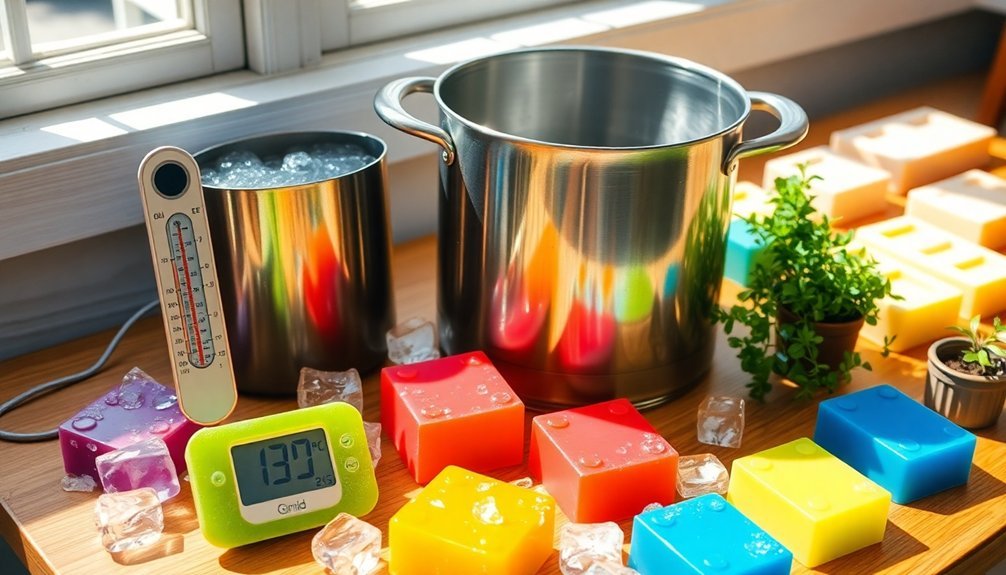
When summer heat creates challenges for soap making, having reliable temperature monitoring tools becomes absolutely essential for success. Your primary arsenal should include an infrared thermometer like the ennoLogic eT650D, which offers non-contact scanning and helpful alarm features to alert you when oils or lye reach target temperatures.
Digital kitchen thermometers provide a reliable alternative with precise readings that guarantee your ingredients stay within the vital 120°F-130°F range. For traditionalists, glass thermometers work too, though they're slower to register changes.
Don't forget that heat-proof equipment is non-negotiable when handling lye solutions. Improper mixing of lye and water can create an exothermic reaction that raises temperatures to dangerous levels.
Finally, establish your workspace in a well-ventilated area to maintain stable temperatures and reduce fume concentration—particularly important during those sweltering summer months when overheating presents a constant risk.
Preventing False Trace When Working With Hard Oils
To prevent false trace when working with hard oils, you'll need to find the temperature sweet spots between 100-110°F where oils remain liquid but don't accelerate trace.
Pre-cooling your hard butters like cocoa and shea to match your lye solution temperature creates balanced conditions for proper emulsification.
You can maintain this equilibrium by melting hard oils thoroughly and continuously monitoring temperatures throughout the mixing process, especially in cooler environments where solidification happens quickly. Using a stick blender efficiently can help you achieve true trace in 1-2 minutes while still maintaining temperature control.
Temperature Sweet Spots
Finding your recipe's ideal temperature range represents one of the most critical factors in preventing false trace when working with hard oils like cocoa butter and palm oil.
Most experienced soap makers aim for temperatures between 100°F and 120°F (38°C to 49°C), ensuring oils remain fully melted while maintaining control over the saponification process.
- Keep temperatures at least 5-10°F above the highest melting point of your hard oils
- Use digital or infrared thermometers for precise temperature readings
- Higher temperatures (110-120°F) accelerate saponification, ideal for simple designs
- Lower temperatures (90-100°F) extend working time for complex designs
- Room temperature can impact your process—adjust accordingly if working in very cold or hot environments
When temperatures fall too low, hard oils solidify, creating the dreaded false trace that leads to incomplete saponification. Remember that lye solution and oils do not need to be within 10 degrees of each other for successful saponification.
Pre-Cooling Hard Butters
Many experienced soapers employ pre-cooling and tempering techniques to manage stubborn hard butters like cocoa, shea, and mango in their recipes.
These solid fats can cause false trace and grainy textures if not properly handled.
To prevent these issues, you'll need to fully melt your hard butters (shea may require up to 180°F), then cool them quickly.
This tempering process guarantees even distribution of fatty acids and prevents the crystalline structures that cause graininess.
Keep your working temperatures around 100°F to avoid premature solidification of butters with higher melting points.
Store pre-cooled butters in airtight containers in your refrigerator for convenience.
Don't worry about reheating them multiple times—it won't degrade their quality.
This approach is especially important during summer months when ambient heat can complicate your soap making. Using ice packs and thermocases for storing butters can help maintain consistent temperatures during extreme heat waves.
Cool Water Bath Techniques for Managing Exothermic Reactions
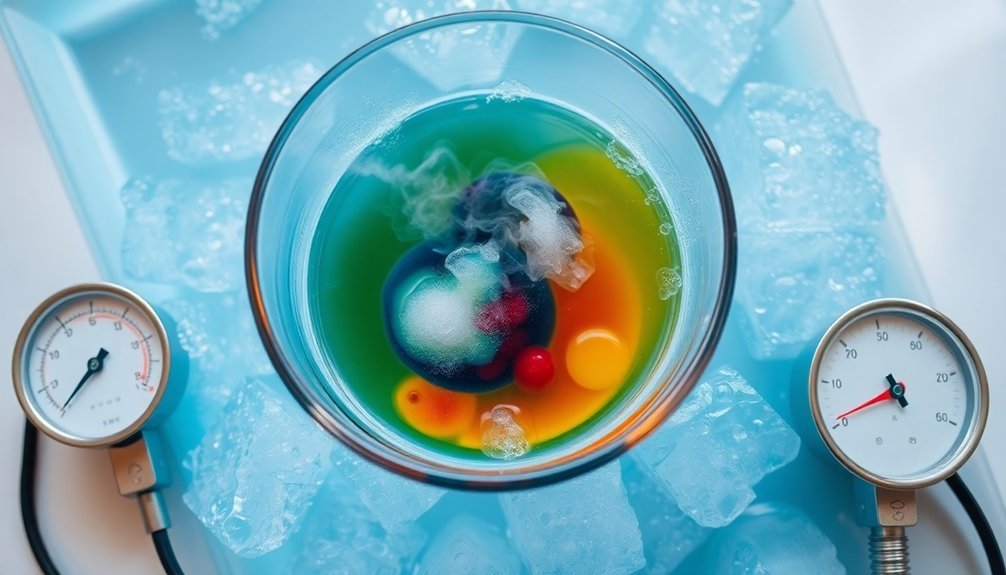
While traditional soap making methods often allow lye solutions to cool naturally, utilizing a cool water bath provides an effective alternative for controlling the intense exothermic reaction that occurs when lye dissolves in water.
When temperatures spike to 200°F, you'll need strategic cooling methods to bring your solution within the ideal 90-110°F range.
- Place your lye container in a shallow basin filled with cold water
- Add ice cubes to the water bath for faster temperature reduction
- Monitor with a thermometer to prevent overcooling below target range
- Remove from bath when temperature approaches 120°F to allow gradual cooling
- Use insulated gloves when handling containers during bath cooling to prevent burns
This approach gives you more control over timing and helps maintain favorable conditions for intricate soap designs. Properly cooled solutions help prevent premature trace acceleration that would otherwise complicate detailed pattern work in your soap.
Refrigeration Strategies for Soap During Hot Weather
When summer temperatures soar, soap makers face unique challenges in maintaining ingredient integrity and controlling the soap making process.
Contrary to what you might think, refrigerating cold process or melt and pour soaps isn't recommended as it prevents proper air circulation and causes glycerin dew.
Instead, use refrigeration selectively. A brief cooling period right after pouring can prevent overheating in extreme conditions.
Reserve your refrigerator space for butters and lotions, which benefit from cooler temperatures to maintain their solid state.
Your best strategy is finding naturally cool, dark storage areas for both ingredients and finished soaps.
Remember that oils and butters become unstable above their melting points—coconut oil liquefies around 78°F.
For ingredients like beeswax with higher melting points, you'll need controlled warming techniques.
The freezer can be an effective emergency solution when recipes containing natural sugars begin to overheat during the saponification process.
Adjusting Recipes to Accommodate Summer Heat Conditions
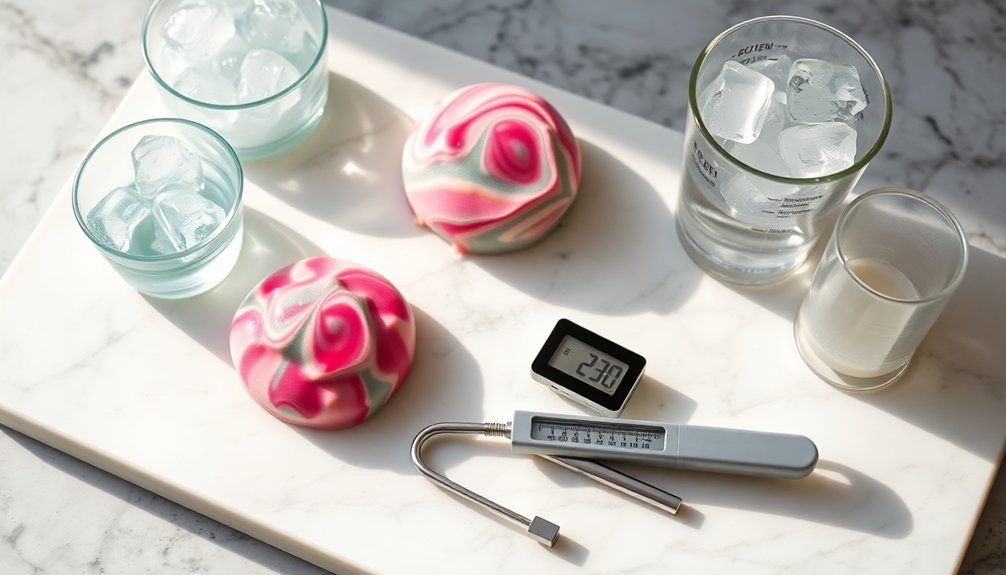
As soap makers master storage strategies for hot weather, recipe modifications become the next challenge to overcome.
You'll need to reconsider both ingredient selection and process timing when summer temperatures rise. Lowering water content helps soap harden faster in humid environments, while sodium lactate can provide additional firmness.
Hot weather soapmaking demands strategic ingredient selection and timing adjustments to ensure proper hardening and prevent production mishaps.
- Choose liquid oils over solid ones when possible, as they require less temperature management
- Adjust for different melting points—coconut oil liquefies at 76°F, shea butter at 84°F, and cocoa butter at 93°F
- Pre-soak your lye solution, allowing it to cool before mixing to prevent overheating
- Work at lower temperatures (90-100°F) to slow trace and prevent soap volcanoes
- Consider the heat transfer method for recipes high in liquid oils, using lye solution heat to melt oils
Timing Your Soap-Making Process for Cooler Hours
Timing the soap-making process strategically can dramatically improve your results during hot weather. Consider starting your soaping projects in the early morning when ambient temperatures are lowest, helping you avoid the challenges of peak heat periods.
When working with temperature-sensitive ingredients like milk or delicate fragrances, cooler hours become even more critical. You'll benefit from cooling your lye solution in advance and maintaining consistent oil temperatures through careful monitoring with an infrared thermometer.
Track each batch's timing with a stopwatch, recording when gel phase begins and ends. This data helps you identify patterns and optimize future sessions.
For larger batches that generate more heat through saponification, cooler starting conditions provide a buffer against overheating and glycerin rivers, giving you greater control over the final product. The exothermic reaction during saponification completes within 24-48 hours, making temperature control especially important in the initial mixing stages.
Climate Control Options for Your Soap-Making Workspace
Creating an ideal climate for your soap-making workspace goes beyond simple temperature considerations. Effective climate control guarantees product quality, extends ingredient shelf life, and provides a comfortable environment for your creative process.
To optimize your soap-making environment, consider these key options:
- Install split system HVAC units for smaller spaces or rooftop units for larger facilities to maintain consistent temperatures between 32°C-43°C.
- Incorporate dedicated exhaust systems to remove caustic fumes during production.
- Use dehumidifiers alongside your cooling system to control moisture levels during soap curing.
- Convert basements or insulated rooms into cooled workspaces for natural temperature regulation.
- Add stainless steel surfaces that resist chemical reactions and maintain workspace cleanliness while not retaining heat.
Regular maintenance of your climate control systems ensures peak performance and prevents major issues while extending the lifespan of your HVAC equipment.
Fragrance and Additive Selection for Hot Weather Soap Making
Selecting the right fragrances and additives becomes essential when making soap during hot weather. For summer soaps, choose fragrances with higher flash points to prevent quick evaporation. Cold process soap making at 120-130°F helps preserve fragrance integrity better than hot processing methods.
Essential oils like peppermint, grapefruit, and lavender generally offer better heat stability than fragrance oils. You'll find tropical scents like coconut, pineapple, and citrus particularly appealing for summer creations. These fragrances provide an uplifting sensory experience that enhances your soap products. Consider blending oils to create unique summer combinations.
For additives, incorporate cooling elements like menthol or peppermint water to create a revitalizing sensation. Exfoliants such as strawberry seeds add scrubbing action, while vibrant natural colorants like spirulina enhance visual appeal.
These thoughtful selections guarantee your summer soaps remain fragrant and effective.
Frequently Asked Questions
Can I Substitute Digital Thermometers With Other Temperature Measuring Methods?
You can substitute digital thermometers with traditional thermometers like jam thermometers, or rely on touch methods if you're experienced. Visual inspection of oils and butters can also indicate when temperatures are suitable for soap making.
How Do Temperature Fluctuations Affect Colored Mica Patterns?
Temperature fluctuations disrupt your mica patterns considerably. When temps get too high, your colors can morph, bleed or fade. Consistent temperatures (120-130°F) guarantee your swirls remain vibrant and patterns distribute evenly throughout your soap.
Does Altitude Impact Soap Temperature Requirements?
Altitude has minimal impact on your soap temperature requirements. You'll still need to maintain 32-43°C (90-110°F) for mixing oils and lye, though you might experience slightly faster drying times due to lower humidity.
Can I Use Frozen Oils to Combat High Ambient Temperatures?
Yes, you can use frozen oils, but they're not ideal. You'll risk false trace if they solidify prematurely. Better alternatives include pre-cooling molds, using air conditioning, or mixing melted and liquid oils together.
How Does Humidity Affect Soap Temperature Control Strategies?
Humidity complicates your temperature control strategies by slowing evaporation, preventing cooling, and causing moisture absorption. You'll need to increase ventilation, consider dehumidifiers, and possibly modify recipes when making soap in humid conditions.
In Summary
When you're making soap in hot weather, you'll find these temperature control techniques essential to your success. Whether you're monitoring with digital thermometers, timing your soaping during cooler hours, or adjusting your recipes, you've got multiple options to maintain control. Don't let summer heat ruin your batches—with proper workspace climate control and strategic ingredient choices, you'll create beautiful soaps regardless of outside temperatures.

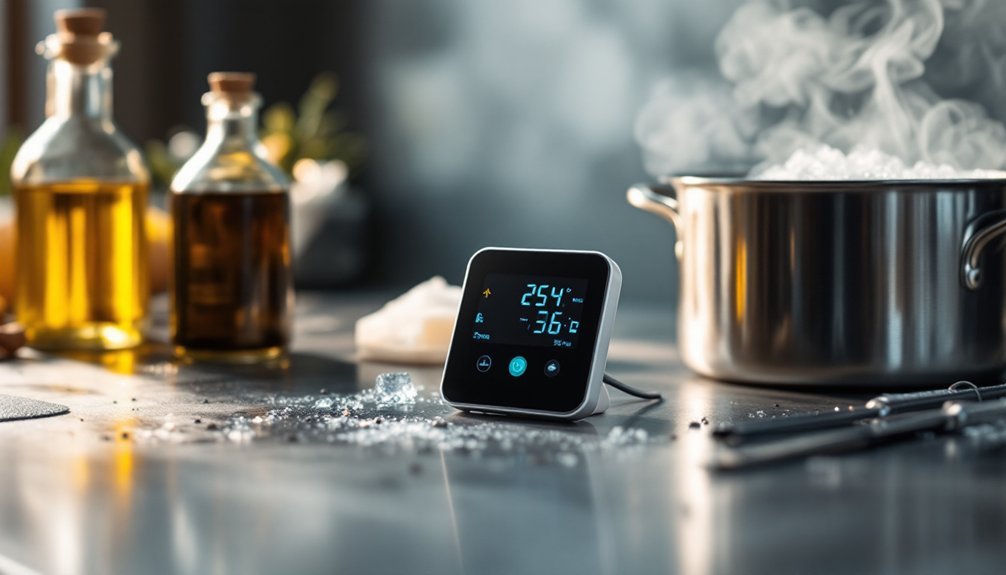



Leave a Reply